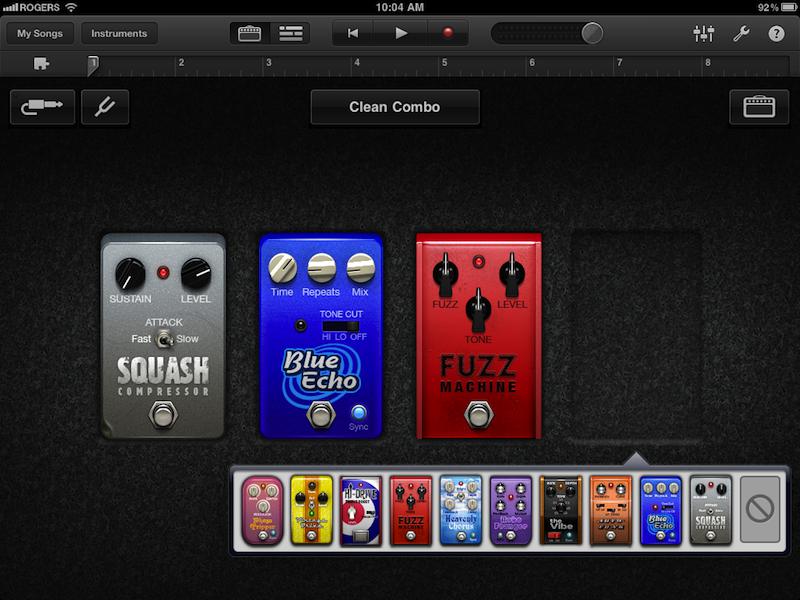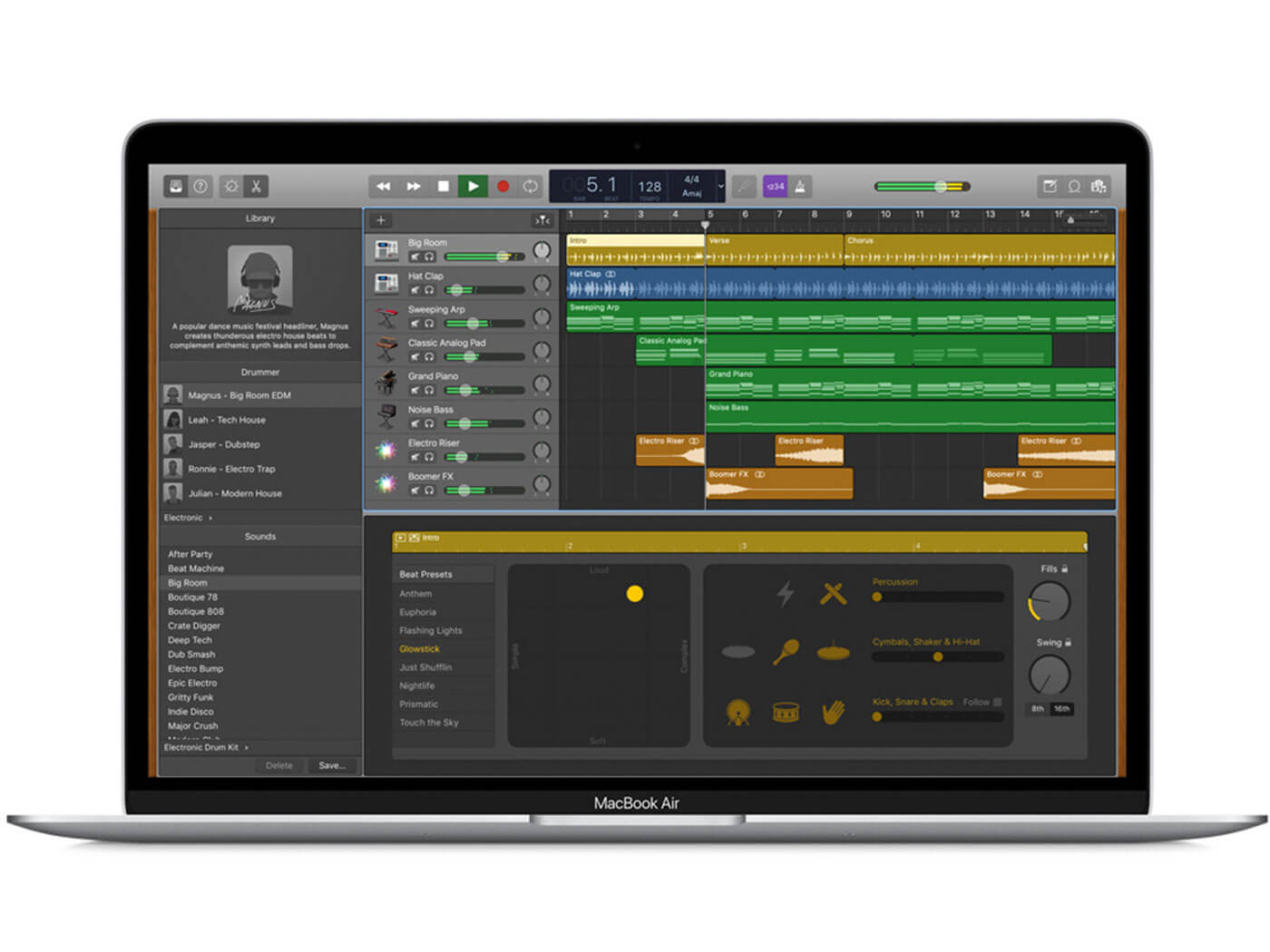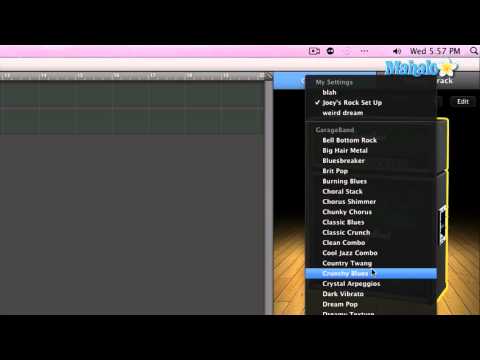GarageBand is a free DAW for all macOS, iPad OS, and iOS users. It is complete with over 10GB of free virtual instruments and effects, including guitar amp simulators, guitar pedals, and more. Plus, you can also use GarageBand’s onboard effects to shape your guitar tone a little bit further—enabling you to create high-quality guitar tracks for your projects.
I did try using the presets when recording guitar, but have moved towards just using Garage Band like a multitrack recorder and getting the sound I want out of an amp and then micing it in with an SM57. It just feels better and more natural that way. In GarageBand for iOS 2.3, use the Sound Library to download additional free sound packs to use in your songs. Sound packs contain individual or combinations of Touch Instruments, Apple Loops, Live Loops templates, and guitar and instrument presets. Garageband Guitar Presets EQ – Channel EQ and Single Band EQ. Filter – AutoFilter, Filterbank, Fuzz-Wah, and the Spectral Gate. Imaging – Direction Mixer, and the Stereo Spread. GarageBand includes a bunch of handy effects presets. You can expand the list of presets by buying the Jam Packs, of course, or go can tweak up your own. It's not a lot of effort to twiddle your own presets, but it seems a little strange that there's no easy way of sharing these with other users. Showing you how you can make LIT Vocal Chains in Garageband very easy. Recording with Autotune isn't hard to record with you just have to have the right key.
To use guitar effects in GarageBand, create a new guitar audio instrument track, connect your guitar, and choose between the hundreds of guitar presets in the sound library. Alternatively, you can also design your guitar tone by selecting the different amps, adjusting the mic positioning, and adding guitar pedals.
GarageBand has dozens of guitar amps, pedals, and presets that enable guitarists to shape the tone in many ways. The presets sound impressive, but you can make your tone sound more professional with a little bit of tweaking.
How Do you Use Guitar Pedals in GarageBand?
To use pedals on GarageBand, you need to click and open the pedalboard menu on the track settings. The icon looks like a guitar pedal next to the tuner and amp menu on the right side of the screen.
It will take you to the pedalboard menu, where you can drag, drop, and arrange pedals in any order. You can also tweak the pedals by turning the knobs—kind of like working with actual guitar pedals.
You can also select different pedal presets by clicking the drop-down menu on the upper-left corner of the pedalboard menu.
How Do I Make My Guitar Sound Better in GarageBand?


The key to making your guitar tone sound better in GarageBand is to adjust the gain, volume, and noise gate to a perfect balance. You need to avoid clipping, but you also do not want the volume or signal to be too low, resulting in a quiet and anti-climactic tone that does not have a good impact on the overall mix.
Choose the right amp and settings
The first thing you need to do is choose an amp or preset. You can locate presets for clean, crunch, distorted guitar, bass presets, and experimental sounds in the sound library.

You can also choose different amps by selecting the amp icon next to the track settings and controls to switch between amps and choose amp preset settings.
You can switch between different amps and presets. Plus, you can even change the mic’s position in this menu, allowing you to design and customize your sound fully.
Adjust the levels
To make your guitar sound better in free software like GarageBand, it starts by adjusting the levels. You can adjust the level on your audio interface first, then adjust the amp and master levels within the DAW.
Choose the right pedals
You can also add and remove pedals from your presets to improve the guitar sound when recording guitar tracks in GarageBand. Ensure that your pedals are in the correct order, which usually starts with compression, distortion, delay, reverb, and modulation. However, you can arrange the pedals in whichever way you like.
Factors that Affect Your Guitar Sound in GarageBand
Many factors affect your guitar sound and overall tone in GarageBand, such as the hardware you are using, the guitar itself, and the settings in GarageBand. Sometimes adding too much gain will affect the tone, making it sound a little bit dirty on the mix.
Volume and Gain
Volume and gain control of the signal coming from the guitar and your preamp. (audio interface) It is always best to adjust the sound before you start recording instead of fixing the sound in post-production—especially for audio tracks. Unlike MIDI tracks, you cannot modify the velocity of each note, and it is not a good idea to rely on virtual effects to fix the volume, especially if you want a professionally-sounding guitar mix.

You want to adjust the gain and output from the audio interface first before adjusting the volume within your DAW. The right levels can reduce peaking and clipping even when you accidentally strum or pluck the strings too hard.
Gear
The equipment you are using can also affect the overall sound output. To get the best sound, make sure you are using an audio interface with a built-in preamp. Your guitar can also affect the sound, so make sure you change the strings if they are old to get a full and brighter tone. You also need to make sure that your guitar wirings are intact and shielded to reduce white noise, especially for recording lead and distorted guitar tracks.
Amps
Some amp presets will still need tweaking, especially in a free DAW like GarageBand. Although it is deemed as a beginner DAW with essential functions, a little bit of tweaking and adjustments with the amp’s volume, gain, and EQ levels can go a long way.
Pedals
When building a pedal chain in GarageBand, it is like building a signal chain in real life, where the arrangement of the pedals can affect the overall tone. Make sure to arrange the pedals properly for a cleaner and tighter tone.
Other Effects
Garageband Guitar Presets Reviews
Aside from guitar effects, GarageBand also features a ton of built-in effect plugins, such as reverb, chorus, delay, EQ, bit crusher, pitch, modulation, and many more. You can use these effects for all tracks, including guitar tracks, and these effects can help shape and master your guitar tone to fit well into the mix.
Recording Guitar: Audio Interface vs Mic to Amp
Using an audio interface is the most convenient way to record guitar audio tracks. It is easy, and you don’t need an amp, guitar pedals, and a mic. Also, you don’t need to worry about technical details like mic positioning and other factors.
However, using a solid-state or tube amp will definitely result in a more organic sound, better than any digital instrument, which is best for recording rock and lead guitar tracks. It will definitely have more intensity, and it is the best way to record guitar-driven songs. You can still use digital effects to enhance the guitar sound in post-production, but the power will come from the guitar, pedals, and amp itself. However, tracking guitar using this method is not as simple as using GarageBand presets with an audio interface.
Garageband Guitar Presets

Related Questions:
Guitar Presets In Garageband
How do I listen to the guitar while playing in GarageBand?
To listen to your guitar while playing in GarageBand, you need to turn on monitoring by clicking on the monitor icon. It looks like an upside-down WIFI icon between the track volume and “mute” and “solo” icons. If you want to listen to the recorded guitar track by itself, you can toggle solo or toggle mute on the other tracks.
Can I use my GarageBand as my guitar effects when performing live?
You can use GarageBand as your guitar effects when performing live shows. It may be powerful enough, but you need to make sure you are equipped with a high-end sound card or audio interface to avoid problems with the signal and latency.
There are MIDI pedalboards you can control with your feet, but GarageBand does not support MIDI mapping. Plus, using GarageBand as live guitar effects is not a good idea if you constantly switch effects in the middle of playing. However, it can work if you stick to one or two presets during songs, allowing you to switch in between.